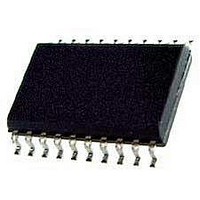CAT522WI-T2 ON Semiconductor, CAT522WI-T2 Datasheet - Page 8

CAT522WI-T2
Manufacturer Part Number
CAT522WI-T2
Description
Digital Potentiometer ICs DPP,NV,256 taps Dual 3 wire,w/Buf
Manufacturer
ON Semiconductor
Datasheet
1.CAT522WI-T2.pdf
(15 pages)
Specifications of CAT522WI-T2
Number Of Pots
Dual
Taps Per Pot
256
Resistance
24 KOhms
Wiper Memory
Non Volatile
Digital Interface
Serial (3-Wire, Microwire)
Operating Supply Voltage
3.3 V, 5 V
Supply Current
600 uA
Mounting Style
SMD/SMT
Supply Voltage (max)
5.5 V
Supply Voltage (min)
2.7 V
Package / Case
SOIC-14
Number Of Elements
2
# Of Taps
256
Power Supply Requirement
Single
Single Supply Voltage (typ)
3.3/5V
Dual Supply Voltage (typ)
Not RequiredV
Single Supply Voltage (min)
2.7V
Single Supply Voltage (max)
5.5V
Dual Supply Voltage (min)
Not RequiredV
Dual Supply Voltage (max)
Not RequiredV
Operating Temp Range
-40C to 85C
Operating Temperature Classification
Industrial
Mounting
Surface Mount
Pin Count
14
Package Type
SOIC
Lead Free Status / RoHS Status
Lead free / RoHS Compliant
CAT522
READING DATA
Each time data is transferred into a DPP control
register currently held data is shifted out via the D0
pin, thus in every data transaction a read cycle
occurs. Note, however, that the reading process is
destructive. Data must be removed from the register
in order to be read. Figure 2 depicts a Read Only
cycle in which no change occurs in the DPP’s output.
This feature allows µPs to poll DPPs for their current
setting without disturbing the output voltage but it
assumes that the setting being read is also stored in
non-volatile memory so that it can be restored at the
end of the read cycle. In Figure 2 CS returns low
before the 13
non-volatile memory setting is reloaded into the DPP
wiper control register. Since this value is the same as
that which had been there previously no change in the
DPP’s output is noticed. Had the value held in the
control register been different from that stored in non-
volatile memory then a change would occur at the
read cycle’s conclusion.
Figure 2. Reading from Memory
RDY/BSY
Doc. No. MD-2004 Rev. I
OUTPUT
PROG
DPP
DO
CS
DI
t
o
1
1
2
th
A0
3
clock cycle completes. In doing so the
A1
4
5
D0
6
D1
CURRENT DPP DATA
7
D2
8
D3
NON-VOL ATILE
DPP VALUE
CURRENT
9
D4
10
D5
D6
11
D7
12
8
TEMPORARILY CHANGE OUTPUT
The CAT522 allows temporary changes in DPP’s
output to be made without disturbing the settings
retained in non-volatile memory. This feature is parti–
cularly useful when testing for a new output setting
and allows for user adjustment of preset or default
values without losing the original factory settings.
Figure 3 shows the control and data signals needed
to effect a temporary output change.
settings may be changed as many times as required
and can be made to any of the two DPPs in any order
or sequence.
effect long as CS remains high. When CS returns low
all two DPPs will return to the output values stored in
non-volatile memory.
When it is desired to save a new setting acquired
using this feature, the new value must be reloaded
into
programming. This is because the CAT522’s internal
control circuitry discards from the programming
register the new data two clock cycles after receiving
it if no PROG signal is received.
Figure 3. Temporary Change in Output
RDY/BSY
OUTPUT
PROG
DPP
DO
CS
DI
the
t
o
Not Recommended for New Design
1
1
DPP
2
A0
3
A1
4
NON-VOL ATILE
The temporary setting(s) remain in
DPP VALUE
CURRENT
D0
D0
5
wiper
6
D1
D1
7
CURRENT DPP DATA
NEW DPP DATA
D2
D2
8
D3
D3
Characteristics subject to change without notice
9
control
D4
D4
10
D5
D5
D6
D6
11
© 2008 SCILLC. All rights reserved.
D7
D7
12
register
DPP VALUE
VOLATILE
NEW
N
DPP wiper
N+1 N+2
NON-VOL ATILE
DPP VALUE
CURRENT
prior
to
























